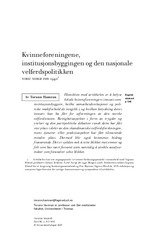| dc.contributor.author | Hamran, Torunn | |
| dc.date.accessioned | 2007-10-19T06:22:12Z | |
| dc.date.available | 2007-10-19T06:22:12Z | |
| dc.date.issued | 2007 | |
| dc.description.abstract | Hensikten med artikkelen er å belyse
lokale kvinneforeningers innsats som
institusjonsbyggere, hvilke samarbeidsrelasjoner og politiske
maktforhold de inngikk i, og hvilken betydning deres innsats kan ha fått for utformingen av den norske velferdsstaten. Rettighetsaspektet i form av trygder og ytelser og den partipolitiske debatten rundt dette har fått stor plass i deler av den skandinaviske velferdsforskningen, mens tjeneste- eller praksisaspektet har fått tilsvarende mindre plass. Dermed blir også kvinnenes bidrag fraværende. Det er sjelden nok å rette blikket mot emner og felt som har vært forsømt uten samtidig å utvikle analysemåter som forandrer selve blikket. | en |
| dc.description.abstract | Prior to 1940, at least 35 institutions had been established in Northern Norway under the aegis of voluntary associations affiliated to the three largest humanitarian organisations in Norway. This article discusses the role of these associations as institution-builders, and, more specifically, the institutions founded, owned and run by local associations of women volunteers providing non-professional care and services for the sick and convalescent in Nordland in Northern Norway. All these associations were led and run by women and became important institutions in the local communities they served. Together, they must also have had some influence on the very structure of these emerging institutions in Norway, and consequently have a place today in the more extensive discussion of the status of women in the growth and shaping of the Norwegian welfare state.
One principal objection to previous research is that the growth of the welfare state was linked too closely to policy at national level – to government, to decision-making powers and to formal structures. This choice of perspective resulted in the absence of women’s organisations from empirical analysis. Criticism was countered with the claim that the conclusions reached would nevertheless have been the same; namely, that while women had scope for action locally they did not influence national legislation. This response builds implicitly on the role of the welfare state defined as the development of welfare policies above all other levels of governance and which ascribes particular importance to the legislation. In other studies, women’s efforts are characterised as much stronger at local level than at central government level. It is maintained equally that women’s organisations in Norway influenced both the ideology of the welfare state, that is to say the principle of universality, the very core of the Norwegian welfare state, and the shape of what gradually became public policy. The explanation given is that co-operation between the voluntary organisations and the public authorities was close. The broadly female-dominated organisations enjoyed the confidence of the local communities and of the local and central political institutions, which opened up possibilities for co-operation with both local and central government authorities and professions. This perspective, however, is open to debate.
The purpose of this article is to explore the efforts of local women’s associations in founding institutions, to discern the co-operative relationships and political power environments of which they were a part, as well as the significance their efforts may have had in shaping the Norwegian welfare state. The article also demonstrates that it is not enough merely to focus one’s enquiries on subjects and fields that have been neglected, but that it is necessary, in addition, to develop analytical methods that change the investigative perspective itself. | en |
| dc.format.extent | 231393 bytes | |
| dc.format.mimetype | application/pdf | |
| dc.identifier.issn | 0018-263x | |
| dc.identifier.uri | https://hdl.handle.net/10037/1217 | |
| dc.identifier.urn | URN:NBN:no-uit_munin_1037 | |
| dc.language.iso | nob | en |
| dc.publisher | Universitetsforlaget | en |
| dc.relation.ispartofseries | Historisk Tidsskrift 86(2007) nr. 3, s. 411-430 | en |
| dc.rights.accessRights | openAccess | |
| dc.subject | VDP::Humaniora: 000::Historie: 070::Kvinnehistorie: 073 | en |
| dc.subject | VDP::Humaniora: 000::Historie: 070::Sosialhistorie: 072 | en |
| dc.subject | VDP::Humaniora: 000::Historie: 070::Kulturhistorie: 075 | en |
| dc.subject | kvinneforening | en |
| dc.subject | velferdspolitikk | en |
| dc.subject | institusjonsbygging | en |
| dc.subject | det sivile samfunn | en |
| dc.subject | velferdsstat | en |
| dc.title.alternative | Women’s associations, establishment of institutions and national welfare policy. Northern Norway prior to 1940 | en |
| dc.title | Kvinneforeningene,
institusjonsbyggingen og den nasjonale
velferdspolitikken.
Nord-Norge før 1940 | en |
| dc.type | Journal article | en |
| dc.type | Tidsskriftartikkel | en |
| dc.type | Peer reviewed | en |


 English
English norsk
norsk